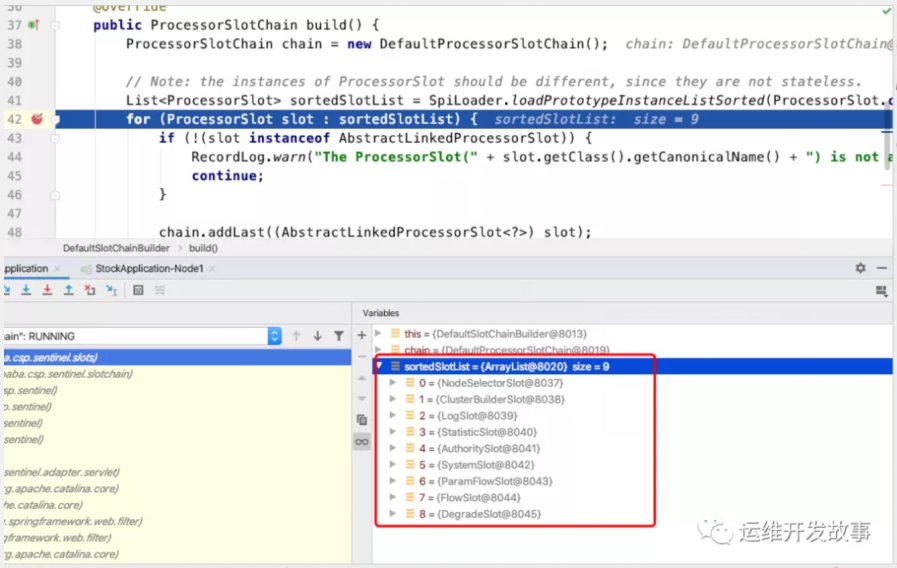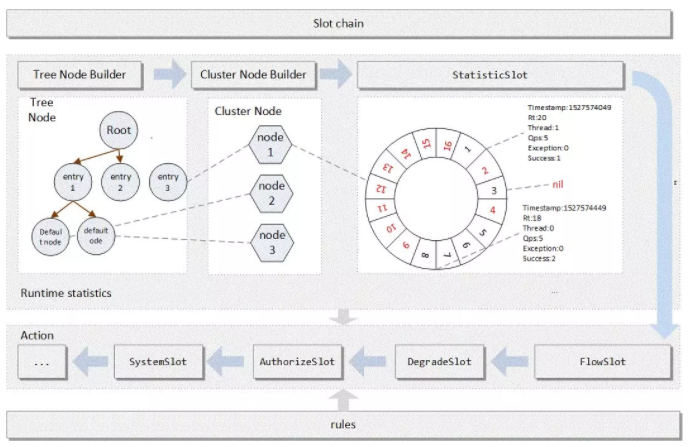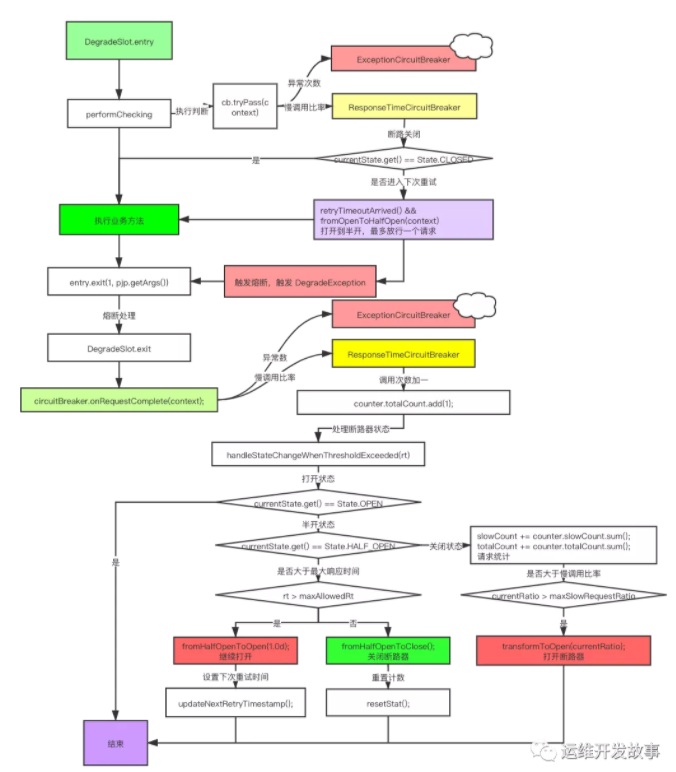我们在项目中添加 Spring Cloud Sentinel 依赖添加后 spring-cloud-starter-alibaba-sentinel 在 Spring-Boot 启动的过程中回去初始化 spring.factories 中的配置信息,如:SentinelWebAutoConfiguration 、SentinelAutoConfiguration 等配置文件来初始化
再讲代码之前我先声明一下我的版本号sentinel 1.8.0 。后续的所有内容均基于该版本进行
@ResoureSetinel 工作原理
配置流控规则我们最简单的方式就是通过 @ResoureSetinel 的方式来管理,该注解可以直接定义流控规则、降级规则。下面是一个简单的使用例子:
- @SentinelResource(value = "ResOrderGet",
- fallback = "fallback",
- fallbackClass = SentinelResourceExceptionHandler.class,
- blockHandler = "blockHandler",
- blockHandlerClass = SentinelResourceExceptionHandler.class
- )
- @GetMapping("/order/get/{id}")
- public CommonResult<StockModel> getStockDetails(@PathVariable Integer id) {
- StockModel stockModel = new StockModel();
- stockModel.setCode("STOCK==>1000");
- stockModel.setId(id);
- return CommonResult.success(stockModel);
- }
如果大家熟悉 Spring 相关的组件大家都可以想到,这里多半是通过Spring Aop. 的方式来拦截 getStockDetails 方法。我们先看看SentinelAutoConfiguration 配置文件,我们可以找到 SentinelResourceAspect Bean 的定义方法。
- @Bean
- @ConditionalOnMissingBean
- public SentinelResourceAspect sentinelResourceAspect() {
- return new SentinelResourceAspect();
- }
让后我们再来看看 SentinelResourceAspect 具体是怎么处理的,源码如下:
- // 定义 Pointcut
- @Pointcut("@annotation(com.alibaba.csp.sentinel.annotation.SentinelResource)")
- public void sentinelResourceAnnotationPointcut() {
- }
- // Around 来对被标记 @SentinelResource 注解的方法进行处理
- @Around("sentinelResourceAnnotationPointcut()")
- public Object invokeResourceWithSentinel(ProceedingJoinPoint pjp) throws Throwable {
- Method originMethod = resolveMethod(pjp);
- // 获取注解信息
- SentinelResource annotation = originMethod.getAnnotation(SentinelResource.class);
- // 获取资源名称
- String resourceName = getResourceName(annotation.value(), originMethod);
- EntryType entryType = annotation.entryType();
- int resourceType = annotation.resourceType();
- Entry entry = null;
- try {
- // 执行 entry
- entry = SphU.entry(resourceName, resourceType, entryType, pjp.getArgs());
- // 执行业务方法
- Object result = pjp.proceed();
- // 返回
- return result;
- } catch (BlockException ex) {
- // 处理 BlockException
- return handleBlockException(pjp, annotation, ex);
- } catch (Throwable ex) {
- Class<? extends Throwable>[] exceptionsToIgnore = annotation.exceptionsToIgnore();
- // The ignore list will be checked first.
- if (exceptionsToIgnore.length > 0 && exceptionBelongsTo(ex, exceptionsToIgnore)) {
- throw ex;
- }
- if (exceptionBelongsTo(ex, annotation.exceptionsToTrace())) {
- traceException(ex);
- // 处理降级
- return handleFallback(pjp, annotation, ex);
- }
- // No fallback function can handle the exception, so throw it out.
- throw ex;
- }
- }
我们总结一下, @SentinelResource 的执行过程, 首先是通过 Aop 进行拦截,然后通过 SphU.entry 执行对应的流控规则,最后调用业务方法。如果触发流控规则首先处理流控异常 BlockException 然后在判断是否有服务降级的处理,如果有就调用 fallback 方法。通过 handleBlockException 、handleFallback 进行处理。
责任链模式处理流控
通过上面的梳理,我们知道对于流控的过程,核心处理方法就是 SphU.entry 。在这个方法中其实主要就是初始化流控 Solt 和执行 Solt. 在这个过程中会对:簇点定义、流量控制、熔断降级、系统白名单等页面功能进行处理。
1. 初始化责任链
下面是初始化 Solt 的核心代码在 SphU.entryWithPriority
- // 删减部分代码
- private Entry entryWithPriority(ResourceWrapper resourceWrapper, int count, boolean prioritized, Object... args)
- throws BlockException {
- // 初始化责任链
- ProcessorSlot<Object> chain = lookProcessChain(resourceWrapper);
- Entry e = new CtEntry(resourceWrapper, chain, context);
- try {
- // 执行 entry
- chain.entry(context, resourceWrapper, null, count, prioritized, args);
- } catch (BlockException e1) {
- e.exit(count, args);
- // 异常抛出,让 SentinelResourceAspect.invokeResourceWithSentinel 统一处理
- throw e1;
- } catch (Throwable e1) {
- // This should not happen, unless there are errors existing in Sentinel internal.
- RecordLog.info("Sentinel unexpected exception", e1);
- }
- return e;
- }
通过 lookProcessChain 方法我逐步的查找,我们可以看到最终的责任链初始化类,默认是 DefaultSlotChainBuilder
- public class DefaultSlotChainBuilder implements SlotChainBuilder {
- @Override
- public ProcessorSlotChain build() {
- ProcessorSlotChain chain = new DefaultProcessorSlotChain();
- // Note: the instances of ProcessorSlot should be different, since they are not stateless.
- // 通过 SPI 去加载所有的 ProcessorSlot 实现,通过 Order 排序
- List<ProcessorSlot> sortedSlotList = SpiLoader.loadPrototypeInstanceListSorted(ProcessorSlot.class);
- for (ProcessorSlot slot : sortedSlotList) {
- if (!(slot instanceof AbstractLinkedProcessorSlot)) {
- RecordLog.warn("The ProcessorSlot(" + slot.getClass().getCanonicalName() + ") is not an instance of AbstractLinkedProcessorSlot, can't be added into ProcessorSlotChain");
- continue;
- }
- // 添加到 chain 尾部
- chain.addLast((AbstractLinkedProcessorSlot<?>) slot);
- }
- return chain;
- }
- }
2. 责任链的处理过程
我们可以通过断点的方式来查看在 sortedSlotList 集合中所有的 solt 顺序如下图所示:
我们可以通过如下的顺序进行逐个的简单的分析一下
- NodeSelectorSolt
- CusterBuilderSolt
- LogSlot
- StatisicSlot
- AuthoritySolt
- SystemSolts
- ParamFlowSolt
- FlowSolt
- DegradeSlot
对于 Sentinel 的 Slot 流控协作流程可以参考官方给出的文档, 如下图所示:
FlowSolt 流控
通过 NodeSelectorSolt、CusterBuilderSolt、StatisicSlot 等一系列的请求数据处理,在 FlowSolt会进入流控规则,所有的 Solt 都会执行 entry 方法, 如下所示
- // FlowSolt 的 entry 方法
- @Override
- public void entry(Context context, ResourceWrapper resourceWrapper, DefaultNode node, int count,
- boolean prioritized, Object... args) throws Throwable {
- // 检查流量
- checkFlow(resourceWrapper, context, node, count, prioritized);
- fireEntry(context, resourceWrapper, node, count, prioritized, args);
- }
在后续的流程中,会执进行判断具体的流控策略,默认是快速失败,会执行 DefaultController 方法。
- // DefaultController
- @Override
- public boolean canPass(Node node, int acquireCount, boolean prioritized) {
- // 当前资源的调用次数
- int curCount = avgUsedTokens(node);
- // 当前资源的调用次数 + 1 > 当前阈值
- if (curCount + acquireCount > count) {
- // 删减比分代码
- // 不通过
- return false;
- }
- // 通过
- return true;
- }
- private int avgUsedTokens(Node node) {
- if (node == null) {
- return DEFAULT_AVG_USED_TOKENS;
- }
- return grade == RuleConstant.FLOW_GRADE_THREAD ? node.curThreadNum() : (int)(node.passQps());
- }
如果上面返回不通过会回到,那么会抛出 FlowException
- public void checkFlow(Function<String, Collection<FlowRule>> ruleProvider, ResourceWrapper resource,
- Context context, DefaultNode node, int count, boolean prioritized) throws BlockException {
- if (ruleProvider == null || resource == null) {
- return;
- }
- Collection<FlowRule> rules = ruleProvider.apply(resource.getName());
- if (rules != null) {
- for (FlowRule rule : rules) {
- if (!canPassCheck(rule, context, node, count, prioritized)) {
- // 流控规则不通过,会抛出 FlowException
- throw new FlowException(rule.getLimitApp(), rule);
- }
- }
- }
- }
然后会在 StatisticSlot 中增加统计信息, 最后会抛出给 SentinelResourceAspect 进行处理,完成流控功能。我们再来看看这个异常信息,如果是BlockException 异常,会进入 handleBlockException 方法处理, 如果是其他的业务异常首先会判断是否有配置 fallback 处理如果有,就调用 handleFallback 没有就继续往外抛,至此完成流控功能
- try {
- entry = SphU.entry(resourceName, resourceType, entryType, pjp.getArgs());
- Object result = pjp.proceed();
- return result;
- } catch (BlockException ex) {
- return handleBlockException(pjp, annotation, ex);
- } catch (Throwable ex) {
- Class<? extends Throwable>[] exceptionsToIgnore = annotation.exceptionsToIgnore();
- // The ignore list will be checked first.
- if (exceptionsToIgnore.length > 0 && exceptionBelongsTo(ex, exceptionsToIgnore)) {
- throw ex;
- }
- if (exceptionBelongsTo(ex, annotation.exceptionsToTrace())) {
- traceException(ex);
- return handleFallback(pjp, annotation, ex);
- }
- // No fallback function can handle the exception, so throw it out.
- throw ex;
- }
DegradeSlot 降级
断路器的作用是当某些资源一直出现故障时,将触发断路器。断路器不会继续访问已经发生故障的资源,而是拦截请求并返回故障信号。
Sentinel 在 DegradeSlot 这个 Slot 中实现了熔断降级的功能,它有三个状态 OPEN 、HALF_OPEN、CLOSED 以ResponseTimeCircuitBreaker RT 响应时间维度来分析, 断路器工作的过程。下面是一个标准断路器的工作流程:
在 Sentinel 实现的源码过程如下图所示:
Sentinel 通过 Web 拦截器
Sentinel 在默认情况下, 不使用 @ResourceSentinel 注解实现流控的时候, Sentinel 通过拦截器进行流控实现的。初始化类在 SentinelWebAutoConfiguration 它实现了 WebMvcConfigurer 接口,在 sentinelWebInterceptor 方法初始化 SentinelWebInterceptor 等 Bean。
- @Bean
- @ConditionalOnProperty(name = "spring.cloud.sentinel.filter.enabled",
- matchIfMissing = true)
- public SentinelWebInterceptor sentinelWebInterceptor(
- SentinelWebMvcConfig sentinelWebMvcConfig) {
- return new SentinelWebInterceptor(sentinelWebMvcConfig);
- }
我们在 SentinelWebInterceptor 的核心方法 preHandle 中处理,这里面我们又可以看到 SphU.entry 熟悉的过程调用流控的责任链。由于逻辑都类似,此处不再多说。代码如下:
- public boolean preHandle(HttpServletRequest request, HttpServletResponse response, Object handler)
- throws Exception {
- try {
- String resourceName = getResourceName(request);
- if (StringUtil.isEmpty(resourceName)) {
- return true;
- }
- if (increaseReferece(request, this.baseWebMvcConfig.getRequestRefName(), 1) != 1) {
- return true;
- }
- // Parse the request origin using registered origin parser.
- String origin = parseOrigin(request);
- String contextName = getContextName(request);
- ContextUtil.enter(contextName, origin);
- Entry entry = SphU.entry(resourceName, ResourceTypeConstants.COMMON_WEB, EntryType.IN);
- request.setAttribute(baseWebMvcConfig.getRequestAttributeName(), entry);
- return true;
- } catch (BlockException e) {
- try {
- handleBlockException(request, response, e);
- } finally {
- ContextUtil.exit();
- }
- return false;
- }
- }
参考文档
https://github.com/alibaba/Sentinel/wiki
https://martinfowler.com/bliki/CircuitBreaker.html







































